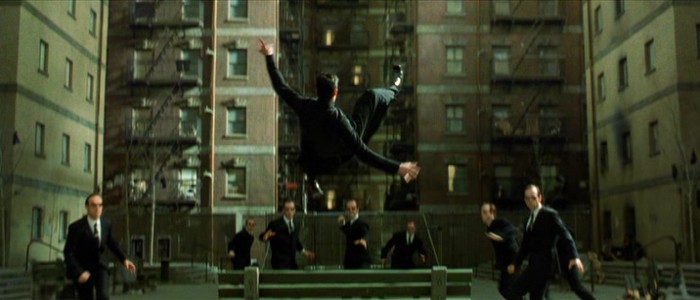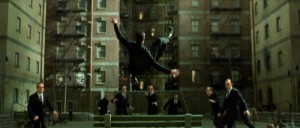
 Archival interview with Charmaine Connelly from the official Matrix website.
Archival interview with Charmaine Connelly from the official Matrix website.
MATRIX: How did you get onto THE MATRIX sequels project?
CHARMAINE: I am one half of the Connelly Makeup FX Team with my husband, Rick, who does fantastic paintwork with silicon appliances, and the Props Manufacture Department on this show needed a specialist in that area. This project actually goes a bit further, bordering into prosthetic makeup where they need things to look as real as possible so they brought us in as specialists, to make one hundred Hugo Weaving / Agent Smith heads look as real as possible.
MATRIX: What is your background?
CHARMAINE: My very first background is hairdressing, and then I started doing makeup in 1996. From that I progressed to special effects makeup in 1997 and it has been a journey since then, working in mostly film and television.
MATRIX: Can you outline some of the films and TV shows you’ve worked on?
CHARMAINE: Recently I saw Darklands, written, produced directed by Jamie Marshall, which is a short film where I was the head of the Special Effects Makeup department, and I am very proud of that. It is all creatures and hopefully it will eventually go to feature length. We made foam latex appliances mostly on a small budget with a very talented team of about six people; it was very much a makeup movie. If it goes to feature it could be the next Planet of the Apes. On Subterano I got to do some nice prosthetics, and for The Rubicon [actually called Do or Die], which was on television, I did some silicon work for that.
MATRIX: What has your role been on the sequels?
CHARMAINE: We are working on one project: making 110 realistic-looking Agent Smith heads. When we started I went over the sculptures with Rick and set out a plan of how to go about making these heads and who we would need on our team to help us get things done on time. Everything has been a calculation because we’re working with big numbers and it has always been about getting certain numbers completed at certain times. Often you work on a film and you just make one head and you make it really well; this time we’ve made one hundred and ten heads really well, which has been quite different.
When we started I did some sculpting, and then I did a lot of the mold making and the actual silicon fabrication, seaming [removing the join in the silicon when removed from the mold], testing and then painting – I’ve been airbrushing.
MATRIX: Could you walk us through the mold making?
CHARMAINE: Once the sculptures were approved, and the three expressions were decided upon, we made three-piece fiberglass molds over the top of our plasticine heads and then once everyone was happy with the mechanics of how the heads moved, we proceeded. We made more molds and decided on colors that the actual base of the silicon would have to be before we could put it into the molds. That was a lot of testing in itself because the whole idea of the silicon is translucency, so we had to decide how much light would go through the silicon and how much wouldn’t; once we decided on that we went into full swing.
MATRIX: How did you test the translucency?
CHARMAINE: We had to pour up as many skins as possible and we just look at it visually. We had to decide how much light we wanted to go through and what was going to look most real. It’s something that with a lot of practice you learn what is going to work and what isn’t. We also did a series of photographs and tests to see the lighting, because silicon heads absorb the light differently to any other material we would normally work with. A photograph is different to the real person under light, so we’ve been present at all the tests with Hugo and have been able to see with our eye and make adjustments that way. The next step was to make as many heads as possible, and then get rid of what minimal seam we had, and then to paint them.
MATRIX: Where was the seam?
CHARMAINE: The seam is on the widest part of the head, technically speaking; that way there are no undercuts in your mold. It runs along the side and follows the inner edge of the ear at the top. We had to trim off any seams that were visible.
MATRIX: Have you created one main head that you use as the color base for all the others?
CHARMAINE: We have had several “hero” heads, which was fine tuned down to a couple. We painted all the heads with basic flesh tones, and then went through each one and made them all precisely the same. To create a flesh tone we had to use a yellow shade as well as red, blue, and green. We maintain continuity by keeping the “hero” head beside us while we’re working, no matter what the light was around us.
MATRIX: Did you actually paint the heads before the eyebrows got punched in?
CHARMAINE: Yes, all the major paintwork had to be completed before the hair. Once the lace front wigs were put on and eyebrows were punched, then we had to go back and fine tune any painting and help disguise the lace and even them up as much as possible.
Originally we thought we wouldn’t have to worry about making any eyes to actually go in the heads, as we always knew that they were going to have the sunglasses on. As we were fine tuning the heads they wanted to go closer, as the eyes sometimes read on camera from behind glasses, so we needed something behind the lenses. So we had someone come in and stencil eye shapes on each head.
MATRIX: How long did you have to create the heads?
CHARMAINE: Once all the testing was done we had about four weeks in full swing production. At first it was just Rick and myself, and then we had Shannon [Stone] and Daniel [Richie] come along and help us.
MATRIX: Was the main testing for the silicon translucency?
CHARMAINE: It was all about that, and also so the Directors [Larry & Andy Wachowski] could feel really confident with what they were going to see. The testing was also so we could meet expectations because they wanted them to look as real as possible and they hadn’t been happy with anything that they had seen produced up to that point. When they got one head from us that was a turning point, and we went on from there.
MATRIX: Do you often have to match a head to a living person?
CHARMAINE: Yes, it’s often like that, but it will be someone who is deceased or decapitated, or has been blown up or something like that. But usually it’s on its own – you don’t see it alongside the person who is living and breathing, and on this show Hugo Weaving is on the set so we’re seeing the prosthetics near the real thing, and they look really great together.
MATRIX: Do you know how Hugo Weaving feels about his replicas?
CHARMAINE: I’ve worked with Hugo before; he’s a very fun guy. He loves this whole thing, it’s really exciting for an Australian actor to have so much attention and so much of him around.
MATRIX: The heads have now been on set for about a week, and they’ve been rained on for hours; how have they held up?
CHARMAINE: Great. The heads and the hair are holding up really well, although the eyebrows and hair want to fall down a little bit. Everyone is maintaining the appearance of the Hugos and we just have to tweak and patch up the necks every now and again because there’s a little bit of wear as they’re turning, so they all stay fresh the entire shoot.
MATRIX: Have there been any challenges you hadn’t anticipated?
CHARMAINE: It’s more time and communication than I thought, always making sure you’ve got what you need with the right reference. They’re the most important things.
MATRIX: Have you spoken to any of the extras operating the heads?
CHARMAINE: No, all I know is that they’re very cold from being rained on. When we started this I thought, we can do this, we can make one hundred and ten heads, we can make as many as we need. Now that the job is finished we see the size of it all on set, that has been the climax of it for me.
MATRIX: Thank you very much, Charmaine.
Interview by REDPILL
December 2001

Be the first to comment